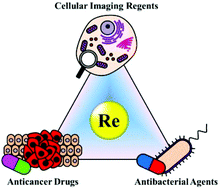Recent development of luminescent rhenium(i) tricarbonyl polypyridine complexes as cellular imaging reagents, anticancer drugs, and antibacterial agents
Abstract
There has been fast-growing interest in the exploitation of the photophysical and photochemical properties of luminescent transition metal complexes in biological applications, with a focus on both diagnostic and therapeutic aspects. In particular, the design of luminescent rhenium(I) tricarbonyl polypyridine complexes as cellular imaging reagents and anticancer drugs has received considerable attention for a number of reasons. First, most rhenium(I) tricarbonyl polypyridine complexes possess diverse photophysical and photochemical properties through the coordination of functionalized ligands. The typical photophysical properties of the complexes such as large Stokes shifts, long emission lifetimes, and high photostability allow them to serve as attractive candidates for optical imaging. Also, the cellular uptake of the complexes can be readily quantified by atomic absorption spectroscopy and inductively coupled plasma-mass spectrometry. Additionally, owing to the characteristic infrared absorption bands and the isostructural relationship between rhenium and technetium-99m, rhenium(I) tricarbonyl complexes have been exploited as multimodal imaging reagents for vibrational and radio-imaging, respectively. Furthermore, the facile photosensitizing properties and the three carbon monoxide (CO) ligands render rhenium(I) tricarbonyl complexes promising candidates as photodynamic therapy reagents and photoactivatable CO-releasing molecules, respectively, for cancer treatment. In this Perspective, we describe the recent development of luminescent rhenium(I) tricarbonyl polypyridine complexes as cellular imaging reagents, anticancer drugs, and antibacterial agents.

- This article is part of the themed collection: 2017 Frontier and Perspective articles


 Please wait while we load your content...
Please wait while we load your content...